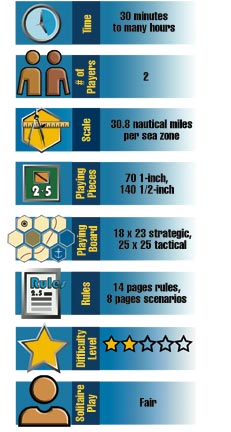Great War At Sea:
U.S. Navy Plan Black
U.S. Navy Plan Black
During the late 1800s, two emerging industrial powers began to build large modern fleets: the United States and Germany. Perhaps inevitably, tensions rose between them. Each entered the imperialist race very late and had to content itself with the leftovers which the British and French had passed by. When the United States seized Spain’s colonial empire in 1898, German jealousy raged hotly. Some German business leaders lusted for the Philippines and Puerto Rico, urging the Kaiser to purchase them from the Spanish before the war ended, or from the Americans afterwards.


German and American squadrons did not, as legend has it, almost come to blows in Manila Bay during the Spanish-American War — the British spread that story, eager to cultivate American public opinion. We included a scenario for that in our 1898 game anyway. But the German and American admirals on the scene did cultivate an intense dislike for one another, and the feelings spread to the top on both sides.
A century later, it’s difficult to say how seriously each nation’s leaders considered war with the other. On either side of the Atlantic, naval planning staffs wrote elaborate scenarios for a possible German-American naval war. It’s these documents that serve as the basis for our game. So while the game is “hypothetical,” it’s drawn from the actual war plans of both nations and is, in its own way, an even more “accurate” wargame than those based on battles or campaigns that did take place.
Though there’s no evidence that either nation’s intelligence services penetrated the other’s naval staff, the two plans oddly mirror one another. Both discounted intervention by other nations. The German “Operations Plan III” posited a trans-Atlantic strike by the German High Seas Fleet to capture Puerto Rico as a base in the first phase of the war, followed by an invasion of the American mainland if the United States refused to negotiate. This second wave would attack a major U.S. port, probably New York but perhaps Savannah.


The U.S. Navy’s “Plan Black” accurately anticipated these notions, though the Americans discounted the lengths to which the Germans prepared to go. For example, the German command planned to tow its shorter-ranged ships across the Atlantic, something the Americans never considered.
Plan Black is one of the famous “Rainbow Plans,” color-coded by nation. The most advanced war plans, known as Plan Orange, covered possible war with Japan. Plan Red addressed war with Great Britain. Plan Black received much less attention than Orange from the American staff, but somewhat more than Red.
The game’s map covers the central Caribbean basin, from Miami in the north to Caracas in the south, and Nicaragua in the west to the Virgin Islands in the east. In addition to the German and American fleets, Plan Black the game also includes the Brazilian and Argentine navies, each of them a respectable force, and the tiny gunboat navies of Cuba, Venezuela and Colombia. There’s a small Dutch naval force, and the U.S. Coast Guard puts in an appearance.
One of the game’s points of popularity, which it shares with Plan Orange and Plan Red, is the inclusion of ships planned or begun but never completed. The Americans receive a pair of aircraft carriers based on the design study using large armored cruiser hulls. There are also three examples of the massive South Dakota class and two battle cruisers of the Lexington class.


Germany receives three further examples of the Baden class; had World War I not intervened these would have been ordered as part of the 1917 program. There are three battle cruisers of the Mackensen class and three of the GK4531 battle cruiser design. There are also three representatives of the GK4251 battleship. And of course Germany receives an aircraft carrier, the proposed conversion of the huge liner Imperator.
We chose the period after the First World War, as the German and American assumptions that Britain would allow the High Seas Fleet to sail down the English Channel unmolested seem unrealistic with hindsight. However, most versions of each plan were filed before the war, and so we included earlier versions in the book supplement Great White Fleet. That book also includes advanced tactical rules for the pre-dreadnought era.
Plan Black and Operations Plan III each assumed no other nations would be involved. In our Dreadnoughts book supplement we included some variations on Plan Black, including the American considerations of Spanish hostility with the re-built fleet (War Plan Olive) and, of course, the Austro-Hungarian fleet (the only Great Power which never received a color designation).
 Links:
Links:
STK #0011
Price: $44.99
Status: OUT OF PRINT